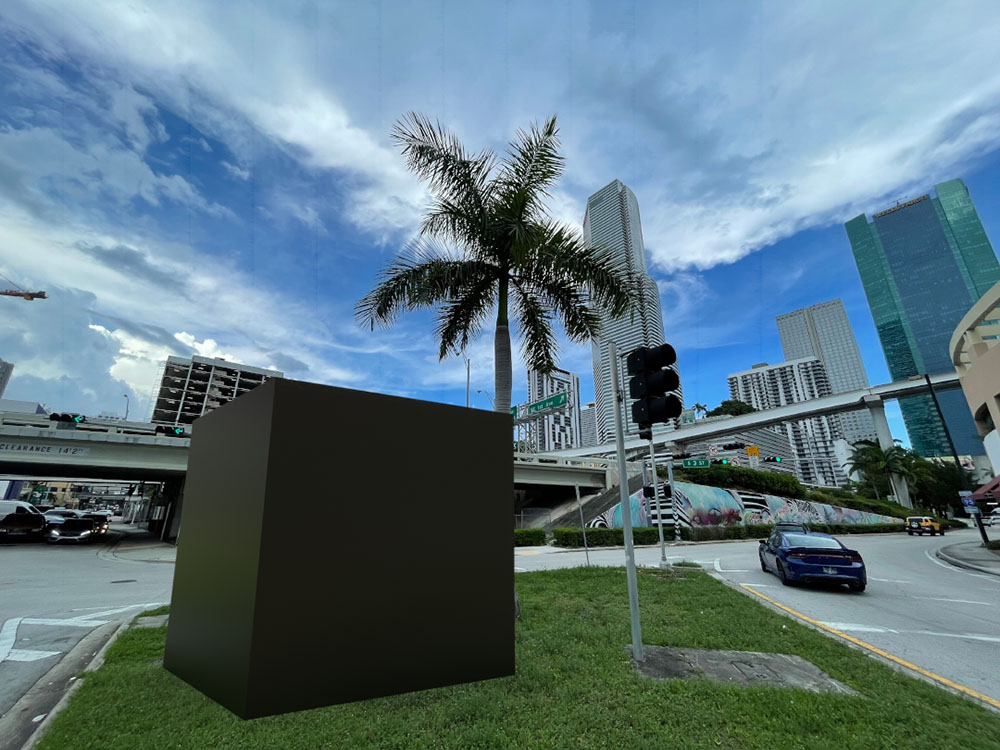
Home » 2022 » Memory Box Monument » Artist’s Statement

Xavier Cortada, “Memory Box Monument: Downtown Miami (rendering),” 2022.
Invited by the Boston Globe to conceptualize a monument that commemorates the passing of one million Americans due to COVID-19, I developed the Memory Box Monument. It is one that by its very design had to be interactive, as the solution to the pandemic involves each and every one of us being engaged (getting vaccinations and booster shots, wearing masks, washing hands). Moreover, unlike any other prior pandemics, this one forced us into the kind of quarantining and isolation that opened up our world virtually – transforming the way we engage and interact with one another online. For that reason, I believe the monument I designed needed to have both a physical and a virtual presence.
I knew the monument must honor the dead, but also provide opportunity for the viewing public to understand and remember the lessons, complexity and absurdity that surround this pandemic. I almost felt like creating a 50 foot tall syringe with a needle stabbing the ground, inoculating America from the diseases that this particular virus so vividly exposed: social inequity, racial injustice, greed, demagoguery, lack of community cohesiveness, and disavowing science.
Unlike other monuments commemorating lives lost to disease, war, accidents, or acts of nature, this COVID-19 monument honors those who died as well as those who have yet to die after they contract the virus or one of its variants.
This disease is controversial. It has been politicized. Our nation is polarized on the prevention & treatment of this disease, so much so that the way Americans address the disease itself is based on ideology not medicine/science.
It remains with us. Many in the global south don’t have the vaccinations, many Americans that have access to vaccinations refuse to receive them, and new variants of the disease will continue to come about. We are creating a memorial that won’t bring closure to a pandemic but will instead mark a point in time along its continuum. It is a continuum that will lengthen in time if we continue to remain polarized and paralyzed in addressing it. And of course, it is a pandemic that is exacerbated by the self-inflicted wounds of a climate crisis that our society refuses to fully acknowledge.
It is a pandemic that is causing a lot of hurt across the globe, but is failing to impart lasting lessons. At the onset, things felt so dire that I thought it would bring about structural changes to our social order. We saw how the working poor were at times the most vulnerable and the most needed. We saw a healthcare system not ready to respond.
During the pandemic, when we most needed our elected officials to speak with one voice and give our country a sense of confidence about what we needed to do as a nation, we witnessed a lack of leadership at the local, state and federal level. This leadership vacuum gave conspiracy theorists and opportunists the space in which to sow doubt, foster despair and distrust, and usher in unnecessary deaths. As we surpass one million victims of COVID-19, we as a society have yet to learn from all of the chaos in a way that prepares us for the inevitability of the next pandemic.
Symbolically, hundreds of Memory Boxes across the American landscape will serve as the pandemic’s conspicuous and enduring reminder so that the tragedy endured does not fade. COVID-19 exposed many societal shortcomings and structural deficiencies. The adverse impact of the pandemic could have been diminished if society would have demonstrated more empathy, compassion, and discipline, and less greed, selfishness, and ideological fervor. These boxes, intrusive and unnatural as they appear across urban and natural spaces, also serve to remind us of the self-inflicted and preventable harm we brought about.
The Box also serves to symbolize the emptiness felt by those who died alone. Their loved ones had no opportunity to say goodbye or be by their side. This pandemic created victims in not just those who died but those who remained living but with an immeasurable loss. As we commemorate the one millionth death, I wanted this monument to serve as a platform for Americans to engage in “Saying Goodbye: An Offering of Gratitude,” a ritual to say goodbye to a loved one they lost but were never able to say goodbye to.
The black cube can be imagined as a box that encapsulates the void in space left by the absence of our loved ones – a permanent marker of the loss.
The Cubes are large and dark and plenty to mark the isolation endured by long periods of quarantine and the darkness that befell all of society, with particular impact to those at its margins. That darkness was heightened by the uncertainty as to when the vaccines would be available, when the pandemic would end, when life would get back to normal.
As this monument gets built, household by household, hospitals by hospital, municipality by municipality, we will hopefully learn the lessons of this pandemic and better prepare for the inevitability of the next one.
– Xavier Cortada